MURRAY REGION



Laura Poole has won this year’s Winter Fair Youth Excellence Award. Page 5.

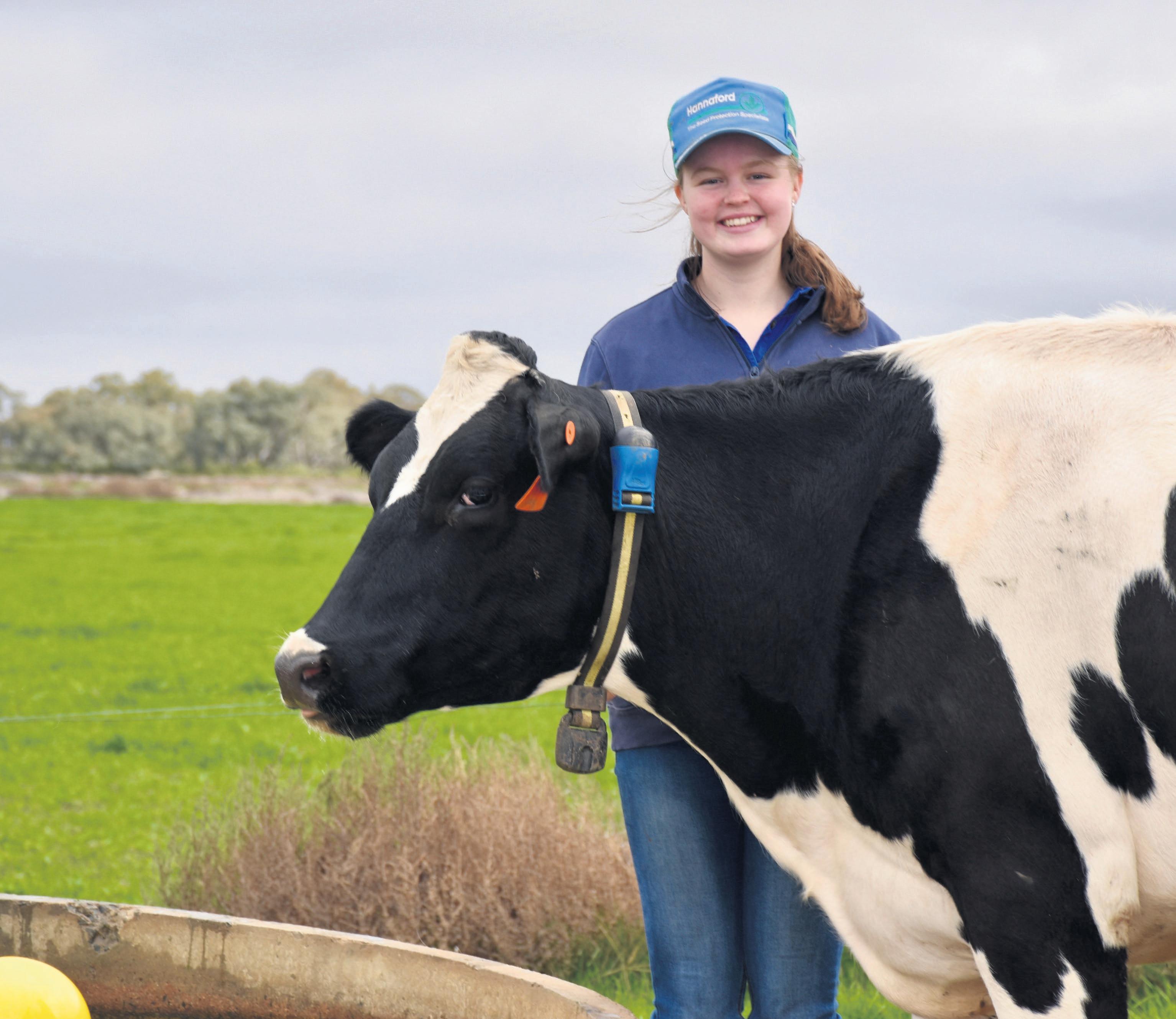
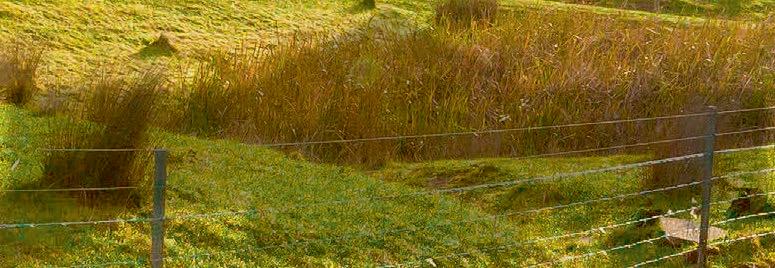

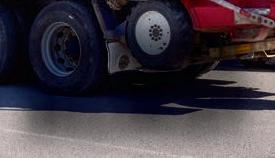



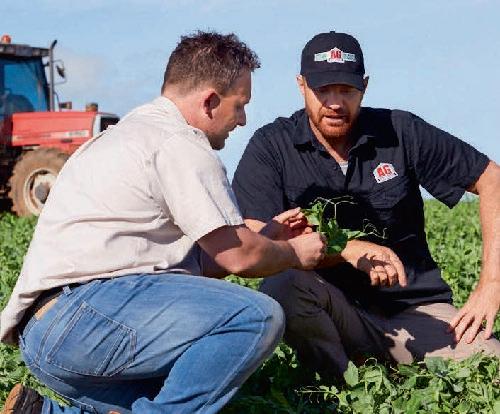

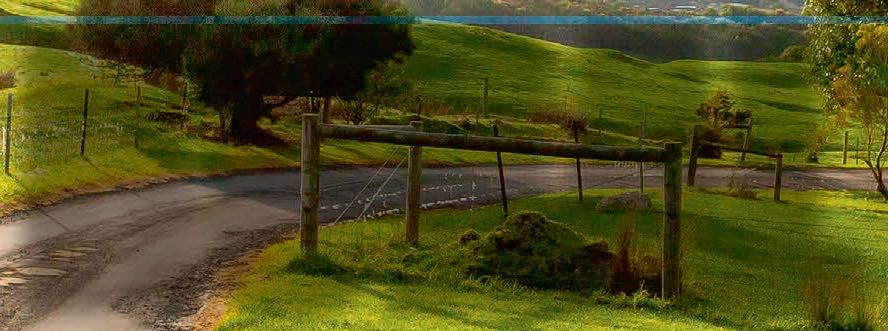




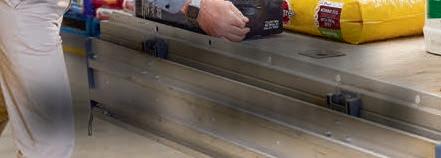

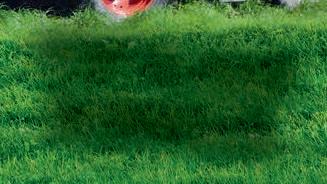


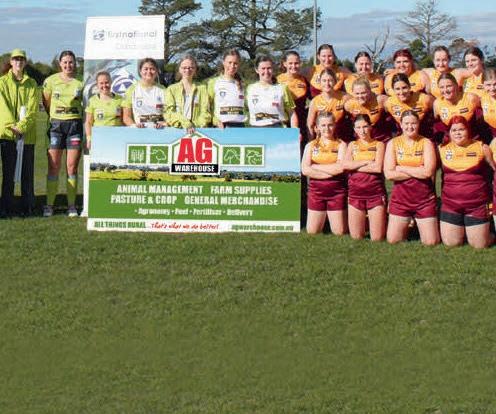
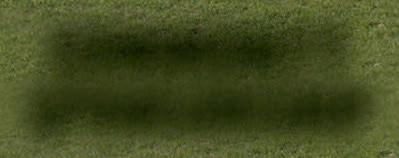
BY RACHAEL NAPIER
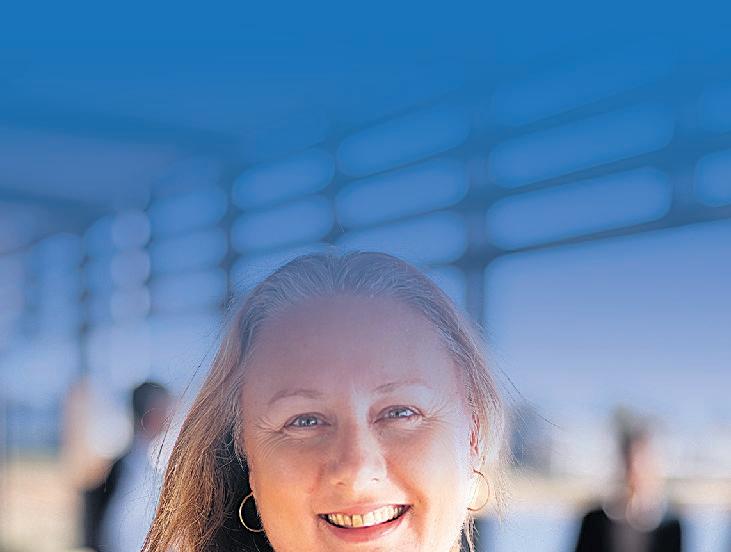

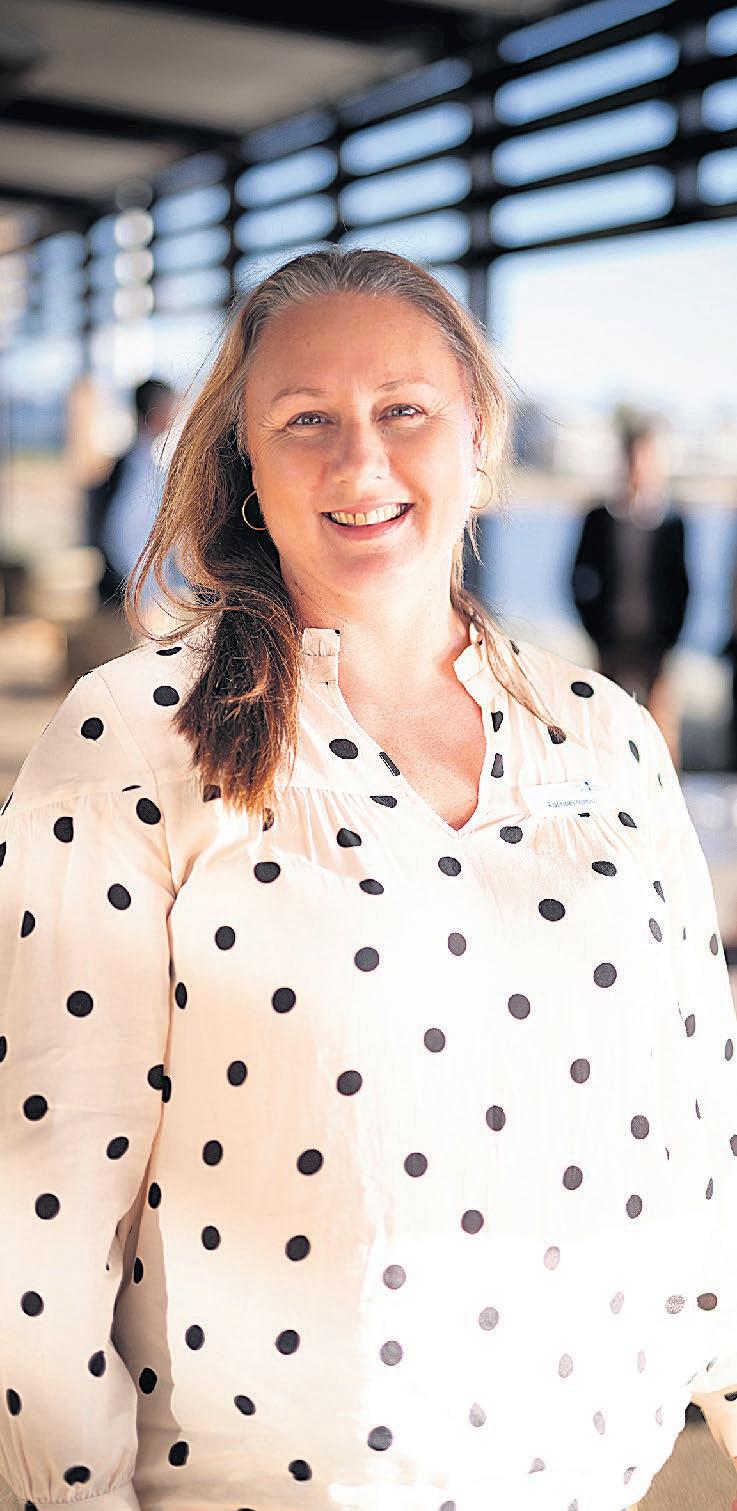
I am very pleased to write that Murray Dairy is getting close to launching its new strategic plan.
I have found this process very satisfying because it’s easy to get caught up in the day-today and forget to stop and think about where we are heading and why it matters.
That happens in business too. The work piles up, and we don’t always take a step back to check whether it’s leading us where we want to go.
For the Murray Dairy Board, this has meant asking: what does success for dairy in our region actually look like? And what role should
Murray Dairy play in helping achieve it?
We’ve identified five key areas where we think we can make the biggest difference.
But at the heart of it all is the ‘farmer voice’.
We’ve got smart, practical people in this region — with ideas that come from real experience — and it’s important we listen and do what we can to help those ideas take shape.
We’re really looking forward to sharing the new plan with you in the months ahead.
‘Farmer voice’ is also a focus for the Gardiner Foundation.
I had the chance to meet with their board recently in Shepparton, along with 15 other farmers and three members of the Murray Dairy Board.
The Gardiner Foundation Board was spending two days in the region meeting with

farmers, industry and service providers, seeing first-hand what’s happening, the impact of their support, and where they can be most useful in the future.
There was great discussion at the lunch I joined and it reinforced to me why we need to do a lot more listening to, and less talking at, farmers.
One of the areas discussed by farmers was the weed and disease burden in fodder crops, which is requiring more management and increased costs.
Murray Dairy is involved in regionally specific research in this area funded by the Gardiner Foundation, as part of a much bigger project involving Dairy Australia, the Queensland Government, Birchip Cropping Group and Irrigation Farmers Network.
If you are interested in learning more, please join the C4Milk roadshow and dinner on August 7, starting in Moama.
There is no cost and it involves a bus trip to visit the trial sites, and a dinner to learn about the research and share ideas.
What we know is that much of the cropping knowledge currently being applied in dairy is being adapted from cereal cropping expertise, which has different dynamics to the dairy industry.
C4Milk is working to understand these differences and the key parameters for sustainable and profitable dairy forage cropping. It would be great to have you join this conversation on continuous fodder cropping.
– Rachael Napier is the Murray Dairy chair.

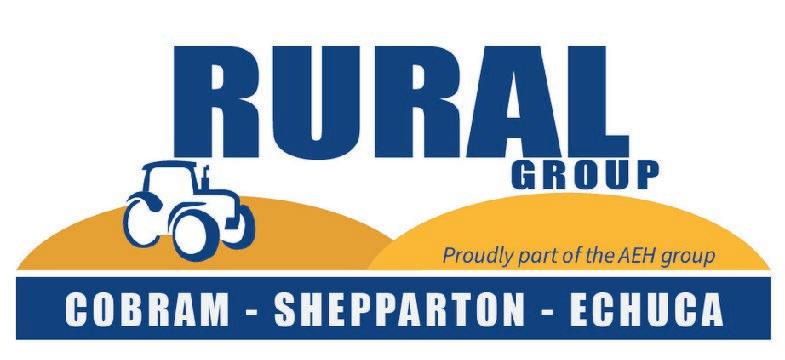
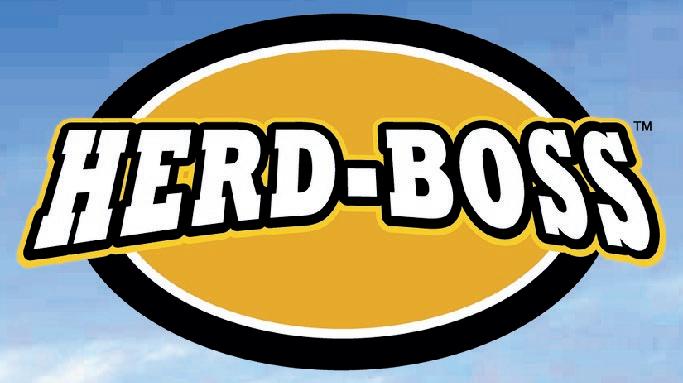


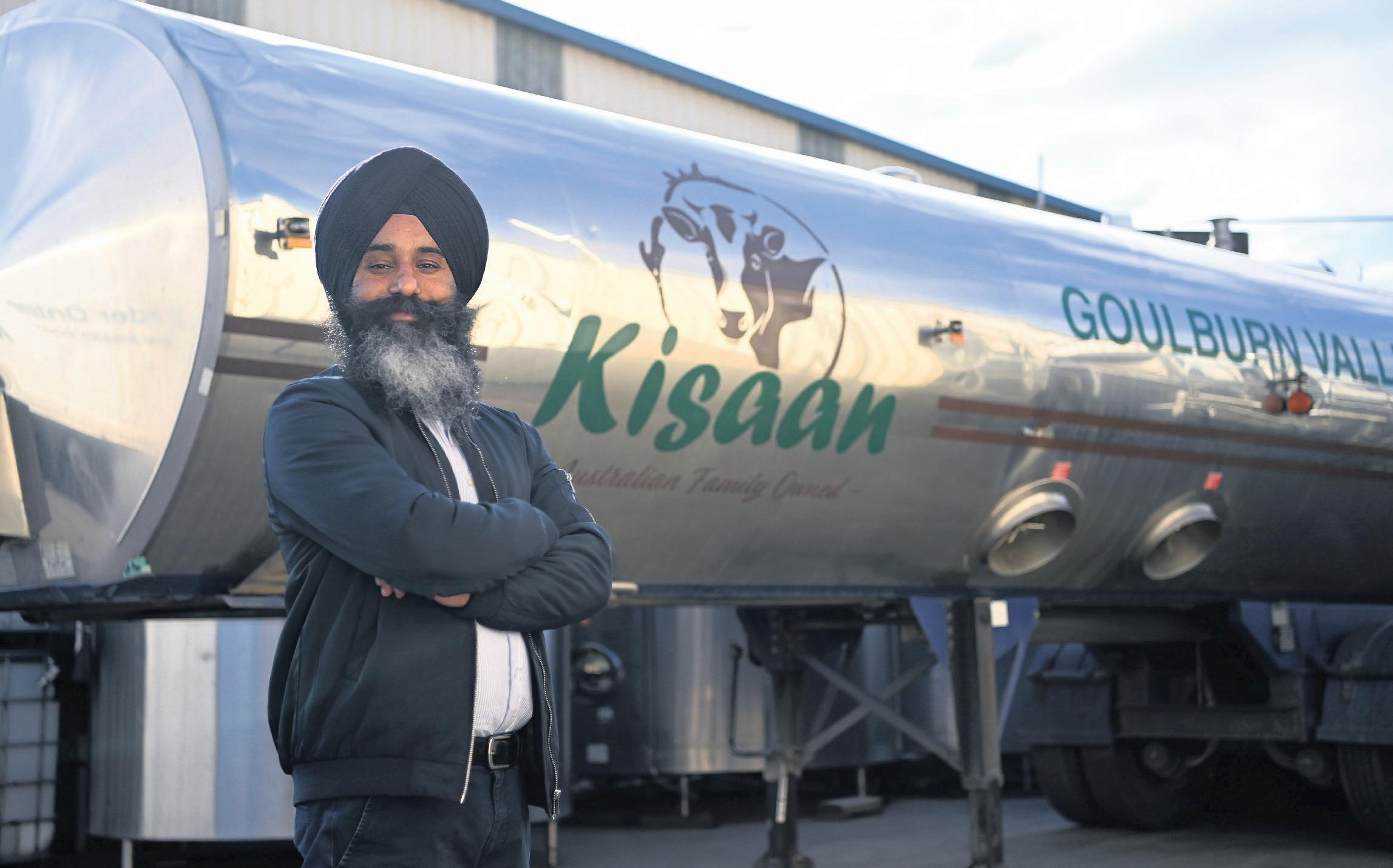
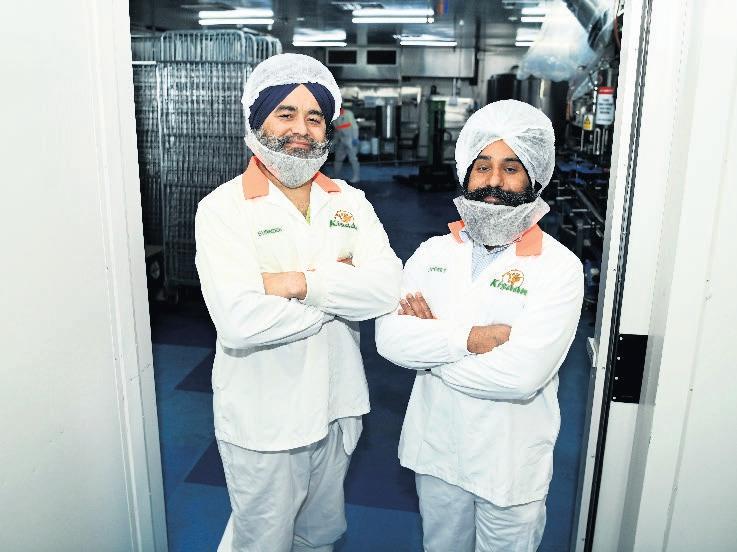

milk and we were trying to develop a perfect product for the type of market we serve,” Mr Singh said.
A SHEPPARTON-BASED dairy company has added another award to its shelf following a successful industry award night.
Kisaan came home with the top prize for their latest product — natural pot-set yoghurt.
“This January, we launched these two products,” co-director Jaspreet Singh said.
“There was a long process to run trials, and there were so many failures, and we had so many community tastings, and finally, we reached on two products — one was natural pot-set yoghurt and the other dahi, which is very well liked in the Indian subcontinent community.”
They entered 15 submissions in the Dairy Industry Association of Australia awards, winning six gold and nine silver positions, as well as the highest scoring natural pot-set yoghurt.
“Usually when they decide they have two, three or four finalists, but in this category, there was only one finalist, and that was us,” Mr Singh said.
“Post announcement of the awards, all three of the judges approached us, and they told us that they couldn’t find anything wrong with the product.
“We couldn’t imagine that in our first year, our product could do so very, very well. We were amazed that we won an award.”
Kisaan started about two years ago, when Mr Singh and co-director Surinder Singh answered a call from the community for different variants of fresh milk.
“We were initially being asked by the people for yoghurt and cheese ... including buffalo

“There was a gap of typical Indian subcontinent-style yoghurt, which we call dahi, so we decided to cater to that market.”
They source their buffalo milk from one of three buffalo dairies in Victoria, sitting in the area between Kerang and Echuca.
When their buffalo milk hit the market, it was selling quicker than they could produce, but now, they produce 4500 litres of milk and curd as well as 100,000 kilograms of yoghurt a week.
They’ve struck gold with their current line of products, but three new products will hit the shelves in the next month, as well as two to release in summer.
“We do buffalo curd, buffalo milk, buffalo ghee and the next one is buffalo butter,” Mr Singh said.
“We do homogenised, non-homogenised, light, skim, organic, all sorts of fresh milks, and we are developing paneer at the moment.”
Their business began as home deliveries to Melbourne and has since expanded to southeast Asian grocery stores, especially Indian and Punjabi stores.
“At the moment, we’re doing about 260 grocery stores in Melbourne,” Mr Singh said.
“We recently expanded up to Griffith. We do home deliveries in Griffith, Shepparton, Geelong.
“There are three physical stores in Shepparton, apart from that, we supply to a few of the cafés in Shepparton, and we do home deliveries every Tuesday.
“We are expanding the distribution of our products to interstate within a month.”
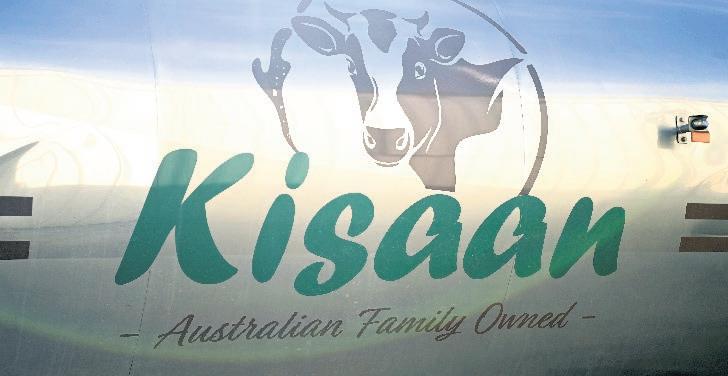
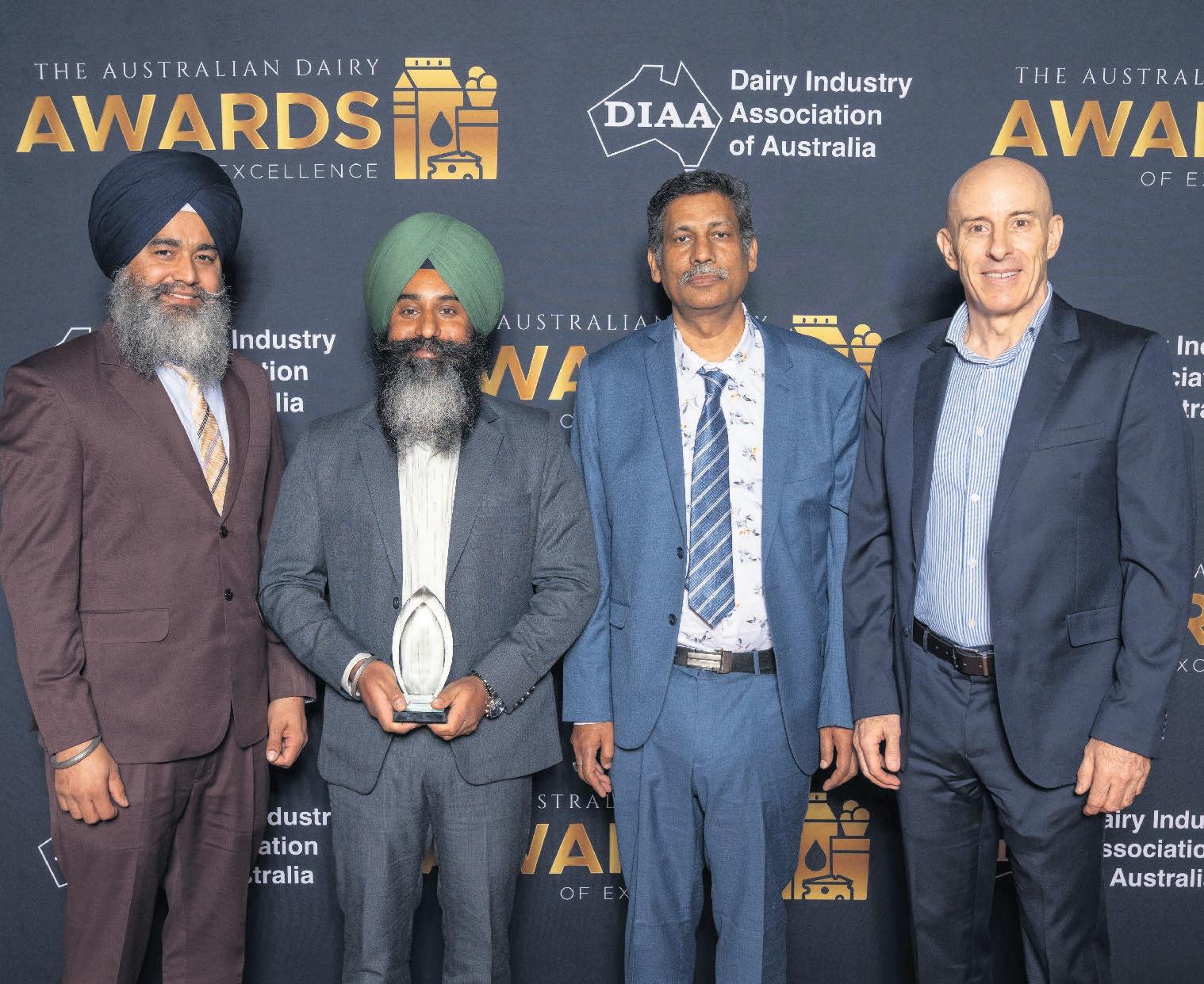
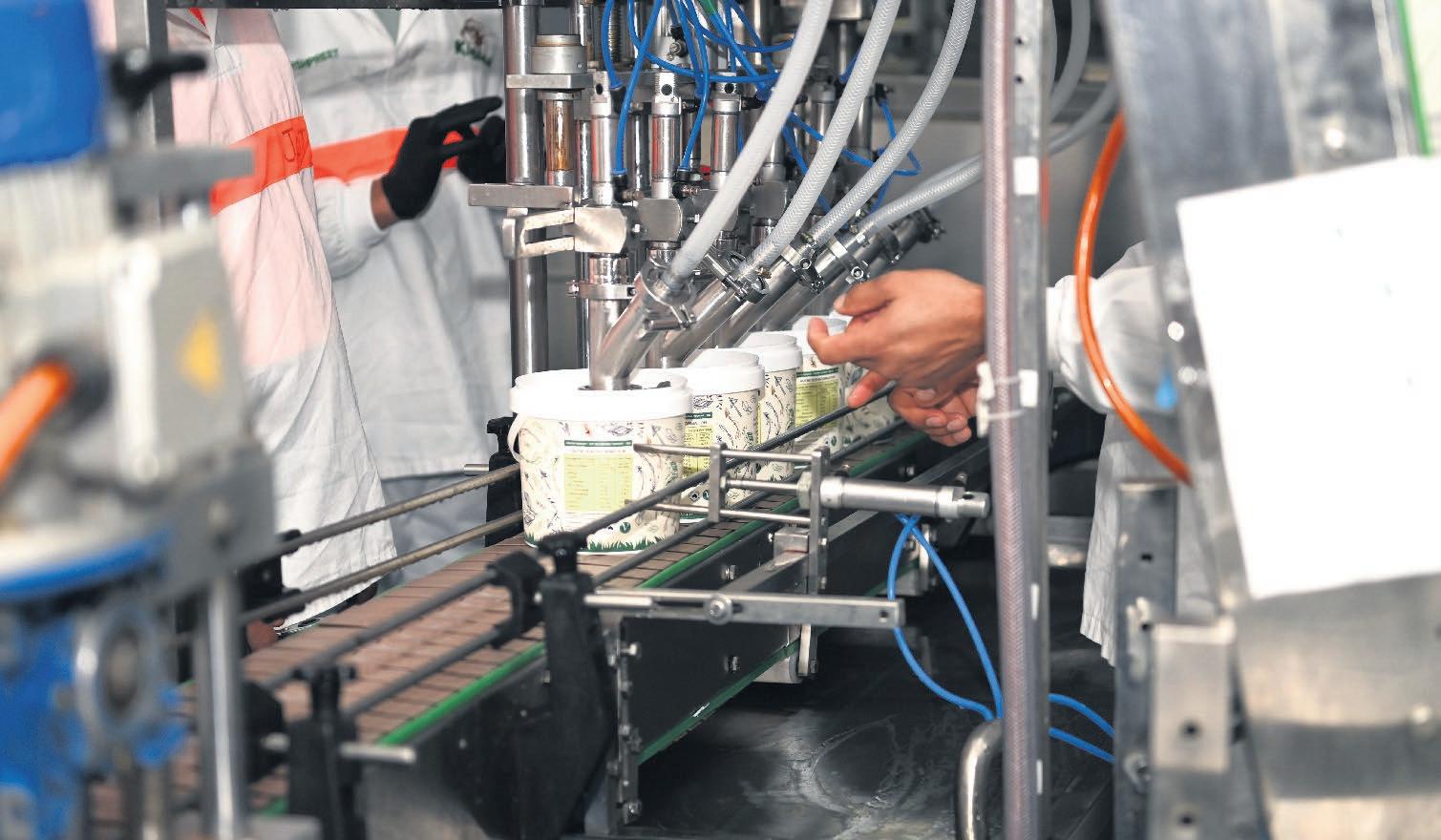
BY SOPHIE BALDWIN
IT IS very much a team effort for the Pooles as they run their 1250 hectare mixed cropping and dairy operation near Pyramid Hill.
In 2022, David and Yvonne Poole — with their children Laura, 14, and Elsie, 12 — bought the family dairy farm outright, in what David describes as a huge financial commitment.
“It’s not an easy life, and it is pretty busy, as we have a diverse production, growing grain, cutting hay and silage and running the dairy and a beef herd, but it certainly is rewarding,” David said.
The family, along with two full-time staff and a part-timer, run the business as a fully self-sufficient closed operation.
“We don’t want to rely on volatile markets,” David said.
“It’s a lot of work, and we won’t be able to do it forever, but while we are young, and we have the energy, we will keep going — we are fortunate to run a feed positive system.”
Memories of drought years have been a significant driver behind the push to conserve as much feed as possible, and part of that includes burying 500 tonne of oats and 270 tonne of vetch in one of the sandy hills on their property, along with conserving as much pit silage as possible.
Fodder growth is supported by around 420ha of irrigation, but the business is heavily reliant on the temporary water market and price per megalitre is certainly cause for concern.
The 260-cow mixed herd is joined exclusively to Holstein, with David aiming for a smaller framed 650kg cow.
“We run a closed herd on a pasture-based system, and our cows do have to do some walking, so the smaller frame is better for the animals and better for the pasture.
“We have put a lot of work into breeding for sound feet and legs, fertility and cell count.”
The split calving herd is joined for six weeks in autumn and nine weeks in spring, which includes two rounds of AI and a mop up with the bulls.
David said they were looking into heading down a 400-day lactation path in the future rather than the traditional 305 days due to several different factors.
In March this year, they installed Allflex collars.
“We were able to put these in with the help of a connectivity grant,” he said.
“We believe they will help us improve fertility and move down the extended lactation path.
“I am not in the dairy as much these days either, and along with the easy dairy program and auto draft, they will definitely help with management and make the job a bit easier for our staff.”
David said this season was looking a little questionable at the start of June, but a total of 60mm of rain for the month, and an application of urea at the right time, made for a more positive outlook.
“Growth is slow, but it does look good, and the cows are still managing to graze twice a day, so we have a bit of feed in front of us.”
Lucerne is grazed, and the cows are supplemented with silage over the summer months.
“A feedpad is very much on the future wish list because the cows do struggle in the heat,” David said.
But as with all management decisions on the farm, it will only happen when the budget allows.
“Yvonne does the business side of our operation, and we couldn’t do what we do without her,” David said.
“We like to stick with the budget and then we know what we can comfortably spend,” Yvonne adds.

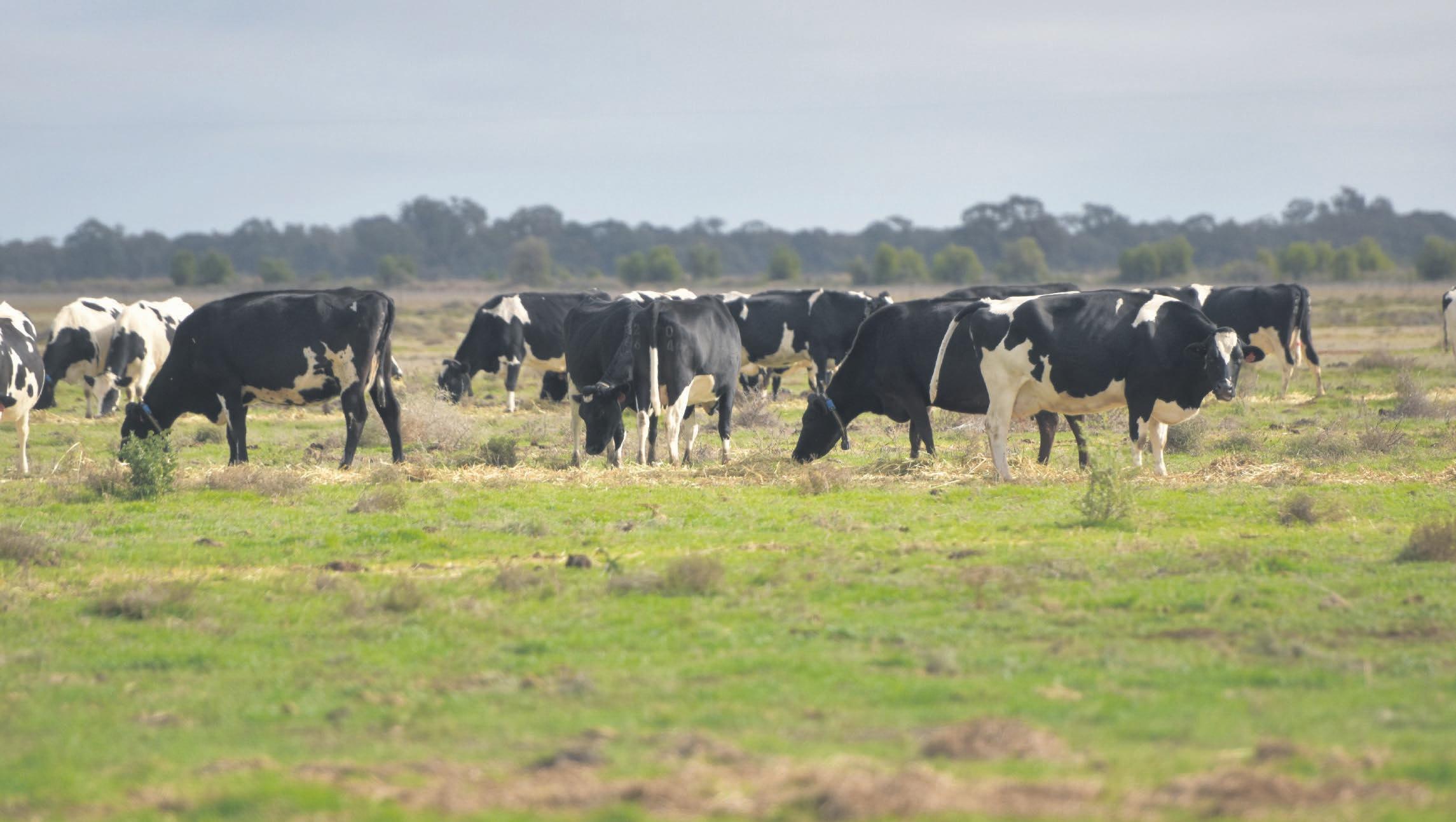
Some of the Pooles’ dry cows.
The family is happy with the way its business is heading, although David’s proposed retirement in 10 years’ time from the dairy side of things might be put on hold, with daughter Laura showing a lot of interest in the cows.
She was recently awarded a Youth Excellence award at the Victorian Winter Fair.
She has also established her own registered stud — Ottreys Bridge Holstein.
“Laura is a natural stock woman, and she is great with the cows, so we will keep going for as long as we can.
“And we will add a few fancy registered cows to the herd now there is a possibility our farm will go on for another generation,” David laughed.
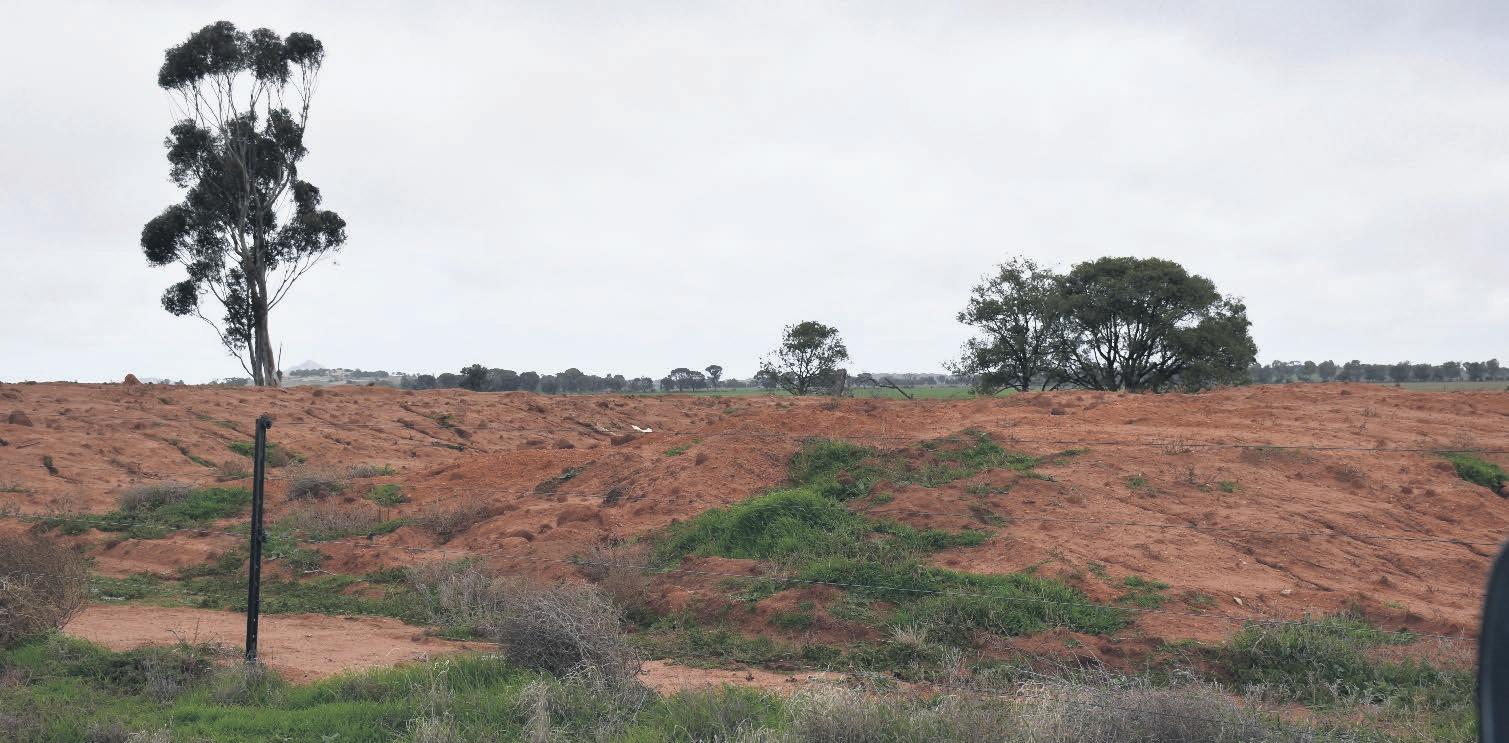
BY SOPHIE BALDWIN
LAURA POOLE has been attending the Victorian Winter Fair for the past three years.
This year her persistence and hard work was rewarded when the 14-year-old was announced the Youth Excellence Award winner for 2025 at the Bendigo event.
“It was unbelievable and a big shock to win,” Laura, from Pyramid Hill, said.
“The Winter Fair is great and I have learnt so much over the years from the junior competitions.
“Located where we are, it is an easy show to get to and you only have to go up to any of the exhibitors and ask a question and you get an answer — everyone is really friendly and happy to share their knowledge with you.
“Everyone is just so encouraging,” Laura said. Laura has been attending dairy shows including International Dairy Week for a few years now.
This year she attended the youth dairy camp at Noorat where she joined around 50 other young people from across Victoria and South Australia to get a taste of all things dairy (the camp was revived last year after a three-year hiatus).
Laura recently started her own registered herd – Ottreys Bridge Holsteins.
She might only have one heifer so far, but it’s a good one – Melaleuca Imagine Dharma, a heifer she brought from Brad and Janelle Sommerville of Melaleuca Holsteins.
Dharma had a successful Winter Fair too, and was declared the Reserve Youth Junior Champion.
Laura said Dharma was a very patient heifer, with clean dairy lines.
“She is a really nice heifer to work with, and as the years go by, I hope to learn more and get at improving my skills with the heifers and cows,” she said.
She lists some of her mentors as Jon Holland, Emily Robins and Brad Sommerville, and there have been many others from the North West Sub Branch who have been encouraging as there is a strong focus on the next generation.
Laura is on the lookout for another heifer to add to her herd and she is looking forward to building up stud numbers over the years.
“I just love working with cows and it is a really good place to be,” Laura said.
Parents David and Yvonne farm a commercial milking herd at Pyramid Hill and they are supportive and encouraging of Laura’s dream to register cattle.
David said he and Laura had a conversation about the dairy farm when she was just eight years old.
“I said I was going to retire from dairying at 55 and Laura said who is going to milk the cows then?
“She has been very keen ever since,” David said.
Laura helps in various activities around the dairy and David describes her as a natural stock woman.
“She spent a lot of time working with


Dharma, breaking her in and washing and clipping her and tending to her daily”.
He said the dairy industry was full of great people who were mentoring Laura and sharing their knowledge.
“We took Dharma to Gorbro Holsteins to assist with the final prep for the show and they did a really great job with her. Glen in particular, has been a great support.
“This side of dairying is pretty new to us and we are all learning a lot,” David said.


BY KYLIE MCKEE
AS WE navigate through a period of evolution in our industry support structures, I’m reminded daily of why our work at Dairy Australia in Murray matters so much.
Our fundamental mission remains crystal clear: to support dairy farmers in our region to build sustainable, profitable operations that can thrive through whatever challenges come their way.
We are fortunate to have an exceptional team, each bringing unique expertise and genuine passion for our dairy community.
Ross Read and Lauren Mackey, our extension team, are the bridge between research and practical on-farm application.
Ross and Lauren are helping to make sure you have access to knowledge that can make a real difference to your bottom line.
Working alongside them, Phoebe Dillon and Laura Morfield serve as our farm engagement leads, and their role is critical to our operations.
Rather than a ‘tick-box’ visit, they’re sitting down with farmers, understanding each operation’s unique challenges and goals, and helping chart pathways to sustainable profitability.
We know that no two farms are exactly alike, and this personalised approach recognises this.
We know (from experience) that farming doesn’t follow business hours or calendar years.
Droughts don’t wait for scheduled appointments, market volatility doesn’t respect workshop timetables, and feed challenges certainly
don’t align with quarterly planning cycles.
This means we’ll be operating with an agility that allows us to respond to seasonal pressures before they arise, providing support when you need it most.
In partnership with the Murray Dairy Board, we recognise the need to ensure every dairy farmer has equitable access to services across the entire Murray region.
You might be managing 50 cows in the western reaches or 500 in the north-east, but you deserve the same quality of support and access to resources.
Our extension staff deliver specialised knowledge-building workshops to support the real challenges farmers face, while our engagement team leads seek to build genuine relationships with farmers, understanding their specific circumstances, and creating a bespoke support plan to help you navigate a path forward — for the long run.
This combination of group learning and individual support creates a comprehensive safety net for our farming community.
I’m confident in our team’s ability to deliver what matters most to Murray region dairy farmers.
We’re here, we’re committed and we’re excited about what we can achieve together.
That’s the foundation we’re building on, and it’s one that will serve our dairy community well for years to come.
For more information about services and support available in your area, contact the team at: dairyaustralia.com.au/murray/team Kylie McKee is the regional manager for Dairy Australia in Murray.
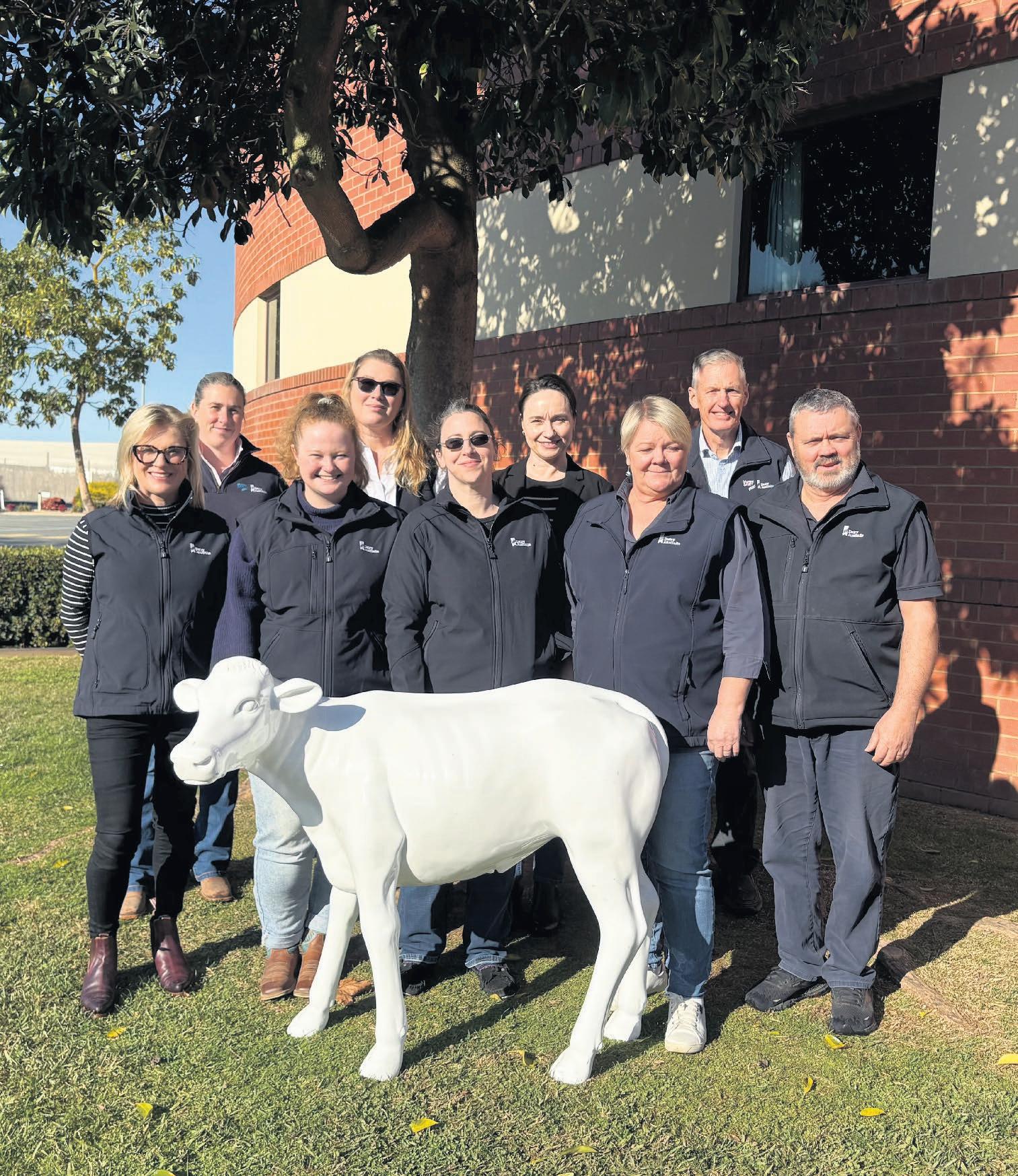
BY DJEMBE ARCHIBALD
AFTER 42 years in the dairy industry, Rob Moyle has stepped down and is ready to embrace retirement.
He grew up on a dairy farm in Bunnaloo, NSW, so he’s never been a stranger to farm life, and after returning from boarding school, he started full-time work at Lancaster.
“Did that for a couple of years. It taught me a fair bit about work ethic,” Mr Moyle said.
“I finished up there and then moved back up to Bunnaloo and did 10 years of broadacre farming.”
In 1982, he got married, but when disaster struck, he had to say goodbye to the town he moved to.
“We were going to stay farming up that way, the farm I was working on, there was a drought. Really, really tough going,” he said.
So, he made a deal.
If his wife could get her job back in the Kyabram area, they would move back. And so she did.
When he moved back, he got a call from a company called J.S. Brooke & Co, asking if he could give them a hand.
And so he did.
“Twenty years later is when I left that business,” Mr Moyle said.
“I was really, really fortunate to get that job, and be able to stay there for as long as I did.” When he did leave, he moved straight back into another dairy role, working as a vet following his interest in mastitis.
“Rod, who was a vet, he convinced me to leave the milk machine business company and go and

work at the vet clinic,” he said.
“We did that for eight years or so, then Rod decided to open his own business called Dairy Focus and asked me to go and work with him.
“So I went and worked with Rod for 10 years.”
He left Dairy Focus in 2019.
“I left in 2019, which was a really tough time for farmers,” Mr Moyle said.
“Water was dear, food was scarce, the milk price was terrible, and, we just basically ran out of work.”
But his trend of getting head-hunted came into play again, when leading dairy possessor Saputo
approached him.
“They asked if I was interested in going and ... helping their milk quality field service, which I did for five years,” he said.
“It was really quite interesting to come from working in a small business to go to a big corporate business.
“Somebody said to me, it’s like trying to turn the Queen Anne around on the Murray River.”
He closed his chapter at Saputo earlier this year, after hearing his body ask for a rest.
“I turned 70 in February, and my body was starting to let me know that,” he said.
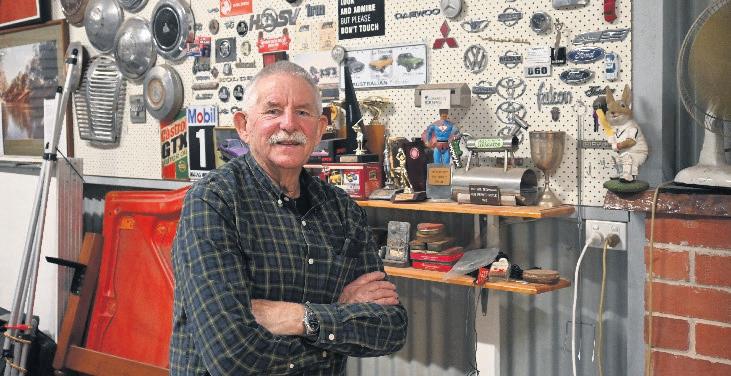

“It was hard to make that decision, because I still feel that I’ve got stuff that I can offer the industry.
“But having a little grandchild made me realise how much I’d missed out on when our two children were young because of working.”
Spending time with family will fill his retirement calendar, as well as travelling in his caravan. His work in the dairy industry has sent him across the world and plastered him on newspaper pages, including Country News.
His travel includes the US, New Zealand and South Africa as well as across Australia.
HAVING TRIED sharefarming early in their dairying careers and learning a few things along the way, Ailsa and Les Damm currently farm with owners Alice and Ian Holloway at Gundowring in the Kiewa Valley.
Ailsa and Les feel better equipped to succeed these days after undertaking three Dairy Australia farm business management programs.
Les grew up on a nearby dairy farm and planned a career in the industry, but the couple’s first sharefarming ventures were curtailed by drought, deregulation and difficult conditions.
However, farming remained in his blood and Les returned to the industry as herd manager for Alice and Ian.
When a neighbouring farm came up for lease, Ian asked if Les and Ailsa would manage it, and they stepped up as contract managers for 10 years.
“We always had a dream to sharefarm or lease. As contractors we were just doing it, but we wanted to benefit from our work. The more we put in, the more we get out of it.”
In 2024, they entered the 50:50 sharefarming agreement, purchasing the 300-strong mixed herd. The refit of the dairy was completed in March 2025 and it’s now full steam ahead.
“Les decided he needed to learn what I do inside on the books, and I needed to learn what he does outside on the farm,” Ailsa said.
“If something happened to one of us, the other could pay the bills and do all the book work.”
They met with Dairy Australia’s Murray team to look at options to improve their business capabilities.
“When we were contractors, we employed all the staff, so we were across that — but we needed to get up to speed with financials and business management,” Ailsa said.
They both completed Dairy Australia’s Farm Business Fundamentals program, which helped them get their business information and financial numbers organised.
“I’d already been doing a lot of it, but the program showed how I should be doing it, rather than how I was doing it,” Ailsa said.
“It gave me the confidence to do my own BAS, whereas that used to be sent to the accountant.
“That means I don’t have to stress about getting it to the accountant and it saves us money.”
The couple then wanted to dig a bit deeper so progressed to Dairy Australia’s Farm
Business Analysis workshop to help them to better understand and analyse farm business performance.
“It was totally different to Fundamentals in that it was dealing with physical farm data — like how much we feed and how much things cost — rather than financial data,” Ailsa said.
“We walked out with a wealth of knowledge that will really help us, and we will start using the DairyBase tool next financial year to make sure we keep to the budget.”
What also appealed to Ailsa and Les was that both courses were completed with weekly online Zoom meetings and homework assignments.
“If we were busy on the farm and couldn’t make it, they recorded the sessions and we were able to go back and watch them,” Ailsa said.
The course guided Ailsa on the value of data and how to use it.
“It was important for me to see the correlation between doing it out in the paddock and running it back through the books and into the program to compare year-on-year.”
Inspired by their successes, Ailsa and Les are now completing Dairy Australia’s Our Farm, Our Plan program.
Since 2019, Our Farm, Our Plan has supported dairy farmers set long-term goals, improve their business performance and manage risk.
“It’s helpful to get what’s in my head and what’s in Les’s head to match up, and then to put it on paper,” Ailsa said.
“We’ve always been on the same page, which is good — but to have it formalised and in print will be helpful.
“It means that at a moment’s notice, anyone can access our plan and know what our plans are for the farm. It will keep everyone on the same page.”
Ailsa and Les have three grown children, including a son, John, who works on the farm as a general farmhand.
Once the Damms pay off the cows and machinery, they plan to lease the farm off owners Ian and Alice.
“We’ve been planning it together. This is their wind-down to retirement — and our way to get ahead,” Ailsa said.
To find out more about how Dairy Australia supports farmers to enhance their farm business management, visit https://www. dairyaustralia.com.au/farm-business or contact your regional office.
From the Dairy Australia Murray Team.
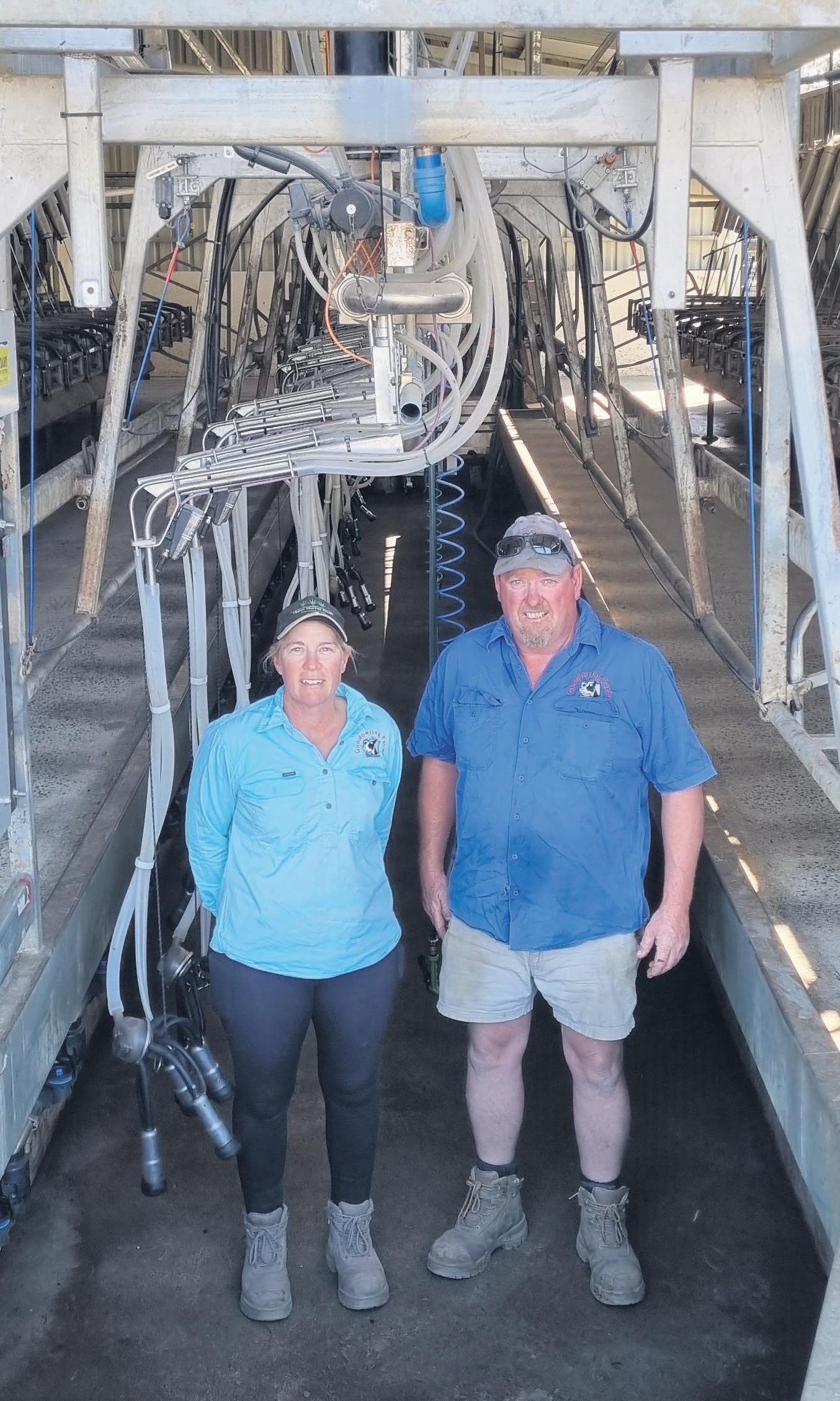
AGRICULTURE VICTORIA’S online farm water calculator has been a reliable tool for land managers to keep an eye on their farm water supplies.
It has now been upgraded and offers an even more user-friendly and accessible experience. This valuable tool helps farmers estimate: Water requirements across the farm. Storage capacity in tanks and dams. Water supply potential from sources like shed roofs, waterways, groundwater and catchment run-off.
Agriculture Victoria climate change development officer Heather Field said by adjusting rainfall inputs, users can explore how their water supply might perform under different climate scenarios, helping them plan for dry seasons or unexpected shortages.
“The calculator now works seamlessly on mobile phones and tablets, making it easier to perform in-field assessments,” Heather said.
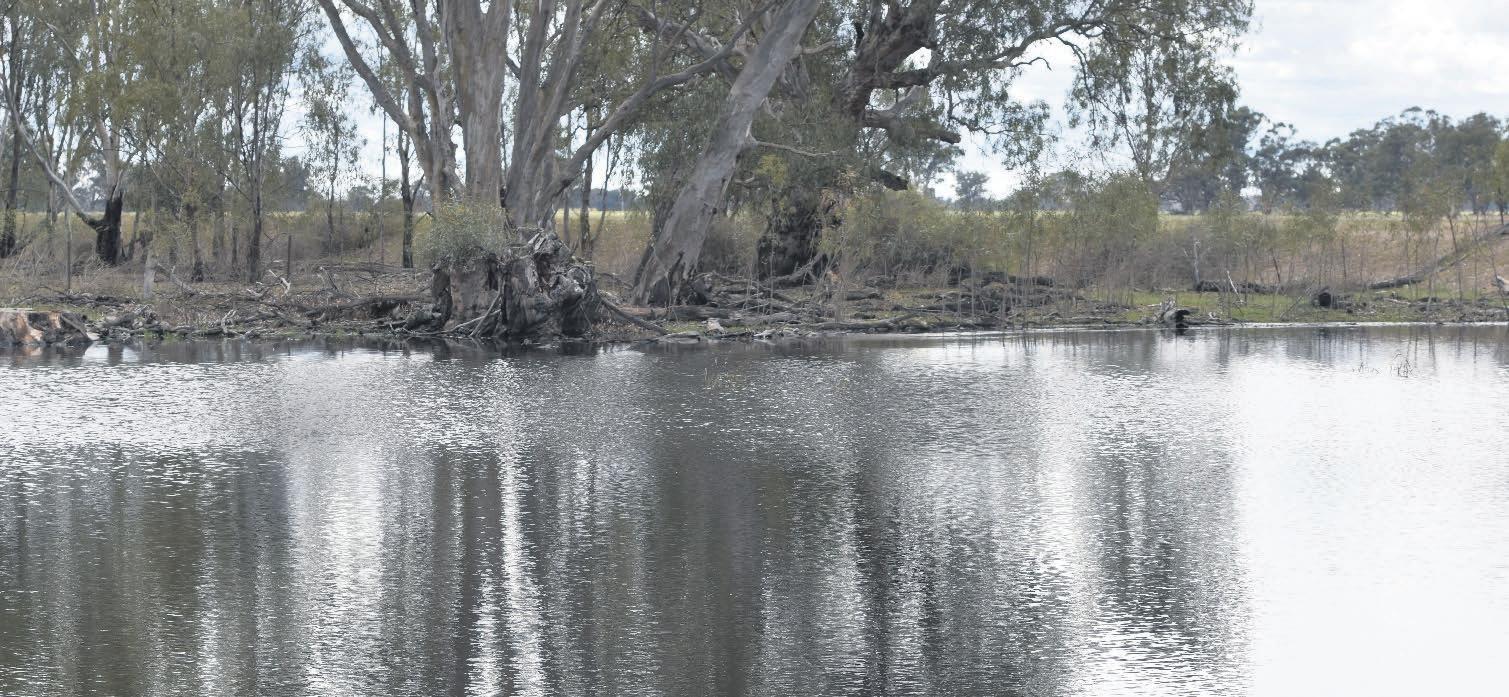
It complements the existing Summer Water Calculator, which focuses on livestock water needs and dam longevity during hotter months. Go to: https://
agriculture.vic.gov.au/support-and-resources/tools-and-calculators/ summer-water-calculator
“For the most accurate results, farmers are
encouraged to use the calculator alongside regular monitoring of water use, storage and supply,” Heather said.
Try the upgraded tool, go to: https://go.vic. gov.au/44llzBj
Across the state any farmer can access technical information and advice to help manage the impacts of increasingly difficult seasonal conditions.
These services will be delivered in partnership with a range of technical experts, including farm business advisors, livestock nutritionists, soil, water and pasture specialists and veterinarians.
The technical decision-making, support program provides tailored advice through oneon-one consultations, webinars, workshops, field days, and online tools and information.
Find more information on drought support at https://www.agriculture.vic.gov.au/ drought or call 136 186.


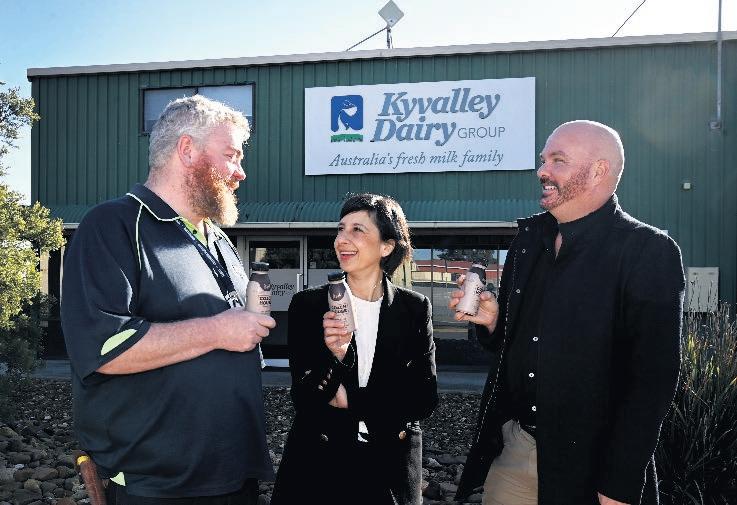
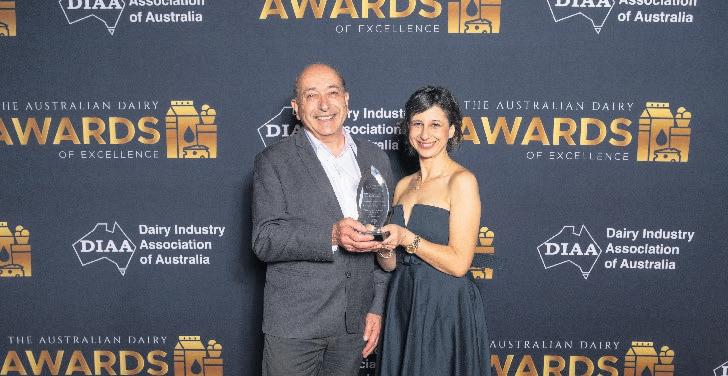
BY DJEMBE ARCHIBALD
WHEN IT comes to choccy milk, no-one compares to Coach House Dairy Co after it took out a national dairy industry award.
Kyvalley Dairy Group’s Coach House Dairy Co Chocolate Milk is officially the best flavoured milk in the state and the country, receiving both accolades at the recent 2025 Dairy Industry Association of Australia awards night.
“I think Coach House is somewhat unique in its category as well, because it’s made with real chocolate, so that is the point of difference,” Kyvalley Dairy Group sales manager Gareth Freer said.
“Everyone that drinks it loves it, and I think it’s got its own uniqueness because of the real chocolate.”
When the team attended the DIAA awards night, they didn’t expect to walk away with the two awards they did, but they couldn’t be happier.
“It was a beautiful night,” Kyvalley Dairy Group general manager Joanna Savva said.
“We weren’t expecting it, to be honest ... but then when our name got called out twice, that was a really big surprise.
“It was quite exciting to get up there.”`
Kyvalley Dairy Group site manager Craig O’Keeffe said it took a bit to get the product off the ground, but it was worth the troubleshooting.
“It was a lot of hard work,” Mr O’Keeffe said.
“All the distribution and picking and everything that we’ve done in-house, it was challenging to start with ... but we’ve got into a flow, and it all works now.
“We produce it twice a week, and it goes all over Australia.”
One of the challenges at the start was having to manually fill bottles, but one of their production upgrades at the Kyabram plant included installing a dual-piston filler.
Ms Savva said the company was always on the lookout for milk supply, with local farmers especially top of mind.
“We are all about having sufficient milk to fulfil all of our sales. It’s all about supporting our farmers,” she said.
IF YOU’RE considering agisting cattle on your property alongside your own herd or sending your stock for agistment elsewhere, taking some simple precautions may help avoid the risk of a costly disease outbreak.
There are three main considerations to protect agisted stock, where possible: Follow your biosecurity plan and the procedures you have put in place to manage risks that could impact your stock or property.
Request or provide as much information as possible about the health of the stock prior to agistment (ask for or provide a National Cattle Health Declaration).
Segregate livestock from different properties into designated paddocks. At a minimum, quarantine newly introduced animals in separate paddocks until their health and disease status is confirmed. There are several diseases or pests that can be introduced to the herd when they are ‘parked’ or agisted.
To minimise the risk of the following diseases or parasites, there are several measures you can take.
Mastitis:
Milk herds separately, for farmers who receive stock; milk the parked cows after the farm herd, and clean milking plant and equipment between uses.
Use good hygiene practices. Continue to monitor bulk milk cell count (BMCC), recording and treating clinical cases.
Bovine Johne’s disease: Run the cattle as separate as possible, keeping in mind that bacteria may still be present in pastures for 12 months after agisted stock have left the property. If Johne’s disease is a concern to you, consider only sending cattle older than 12 months. For
those receiving cattle, ensure stock under 12 months are kept in a separate area from any agisted stock.
Participants in the Johne’s Disease Dairy Score program should be aware that movement of stock to herds with a lower Johne’s Disease Dairy Score may jeopardise their Johne’s Disease Dairy Score.
Pestivirus:
Vaccinate if it is in line with your biosecurity plan.
Keep newly introduced cattle away from the breeding herd, especially if in early pregnancy. Ensure replacement females have developed a strong immunity before joining.
Intestinal parasites:
Drench stock as they arrive at the agistment property (during their quarantine period) and again on their return home.
“We’re always looking for more milk, of course, anyone can get in contact with us.”
Outside their acclaimed chocolate milk, Kyvalley Dairy Group produces milk, cream, butter, flavoured milk including coffee and other products under various brand names.
With a new chief executive officer who began in March, Kyvalley Dairy Group is excited to try new things.
“We’re always looking at innovation and expanding different dairy products,” Ms Savva said.
“We also have a new chief executive officer that started with us in March.
“So we’re looking at different strategies and seeing what the future holds for us, something exciting.”
Other considerations:
In order to maintain lifetime traceability, agisted or parked cattle need to be transferred between PICs on the National Livestock Identification System (NLIS) database. Further information can be found on the Agriculture Victoria website.
As per any other movement when sending cattle to another property (with a different PIC), a National Vendor Declaration (NVD) needs to be filled out.
The welfare of animals is always of the utmost importance. Stock owners and managers, including those who agist, have an obligation to, at all times, provide proper and sufficient food, water and shelter for stock under their care.
By